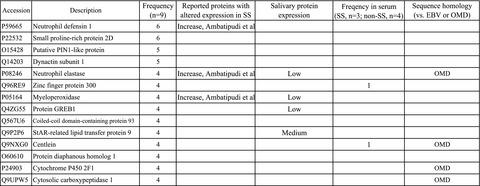当前位置:
X-MOL 学术
›
Clin. Exp. Immunol.
›
论文详情
Our official English website, www.x-mol.net, welcomes your
feedback! (Note: you will need to create a separate account there.)
Immune complexome analysis reveals the presence of immune complexes and identifies disease‐specific immune complex antigens in saliva samples from patients with Sjögren’s syndrome
Clinical & Experimental Immunology ( IF 3.4 ) Pub Date : 2021-01-12 , DOI: 10.1111/cei.13574 K Yamane 1 , H Nakamura 2 , M Hamasaki 1 , Y Minei 1 , N Aibara 3 , T Shimizu 2 , A Kawakami 2 , M Nakashima 3 , N Kuroda 4 , K Ohyama 3
Clinical & Experimental Immunology ( IF 3.4 ) Pub Date : 2021-01-12 , DOI: 10.1111/cei.13574 K Yamane 1 , H Nakamura 2 , M Hamasaki 1 , Y Minei 1 , N Aibara 3 , T Shimizu 2 , A Kawakami 2 , M Nakashima 3 , N Kuroda 4 , K Ohyama 3
Affiliation

|
Sjögren’s syndrome (SS) is a chronic autoimmune disease that mainly damages the salivary and lacrimal glands. Immune complex (IC) formation triggers local inflammation through IC deposition and decreased antigen function. Some ICs can leak from the lesion and into the saliva, but no salivary ICs have been reported to date. We used immune complexome analysis to comprehensively identify antigens incorporated into IC (IC‐antigens) in saliva samples from patients with SS (n = 9) or with xerostomia (n = 7). Neutrophil defensin 1 (67%), small proline‐rich protein 2D (67%), myeloperoxidase (44%), neutrophil elastase (44%), cathepsin G (33%), nuclear mitotic apparatus 1 (33%) and phosphatidylinositol 4‐phosphate 3‐kinase C2 domain‐containing subunit gamma (33%) were identified as new IC‐antigens specifically and frequently detected in the saliva of SS patients. Of these, neutrophil defensin 1, myeloperoxidase, neutrophil elastase and cathepsin G are neutrophil intracellular proteins, which suggests that repeated destruction of neutrophils due to abnormal autoimmunity may be involved in the pathogenesis of SS. We also analyzed serum samples from three SS patients. There was little overlap of IC‐antigens between two of the samples (fewer than 30% of the IC‐antigens in the saliva samples), suggesting that many ICs are formed locally and independently of the circulation. In addition, we found that four SS‐specific salivary antigens show sequence homology with several proteins of oral microbiomes but no antigen has homology with Epstein–Barr virus proteins. The homology between some IC‐antigens and oral microbiome proteins may indicate the impact of oral infection on local autoimmunity through molecular mimicry theory.
中文翻译:

免疫复合体分析揭示了免疫复合物的存在,并鉴定了干燥综合征患者唾液样本中的疾病特异性免疫复合物抗原
干燥综合征 (SS) 是一种慢性自身免疫性疾病,主要损害唾液腺和泪腺。免疫复合物 (IC) 的形成通过 IC 沉积和抗原功能降低引发局部炎症。一些 IC 可以从病变处渗漏到唾液中,但迄今为止还没有关于唾液 IC 的报道。我们使用免疫复合体分析来全面鉴定 SS(n = 9)或口干症(n = 7)。中性粒细胞防御素 1 (67%)、富含脯氨酸的小蛋白 2D (67%)、髓过氧化物酶 (44%)、中性粒细胞弹性蛋白酶 (44%)、组织蛋白酶 G (33%)、核有丝分裂器 1 (33%) 和磷脂酰肌醇 4含有-磷酸 3-激酶 C2 结构域的 γ 亚基 (33%) 被鉴定为新的 IC 抗原,在 SS 患者的唾液中经常检测到。其中,中性粒细胞防御素1、髓过氧化物酶、中性粒细胞弹性蛋白酶和组织蛋白酶G是中性粒细胞胞内蛋白,提示自身免疫异常导致中性粒细胞反复破坏可能参与SS的发病机制。我们还分析了三名 SS 患者的血清样本。两个样本之间几乎没有 IC 抗原重叠(唾液样本中少于 30% 的 IC 抗原),表明许多 IC 是在局部形成的,并且独立于循环。此外,我们发现四种 SS 特异性唾液抗原与口腔微生物组的几种蛋白质具有序列同源性,但没有一种抗原与 Epstein-Barr 病毒蛋白质具有同源性。一些 IC 抗原与口腔微生物组蛋白之间的同源性可能通过分子模拟理论表明口腔感染对局部自身免疫的影响。
更新日期:2021-01-12
中文翻译:

免疫复合体分析揭示了免疫复合物的存在,并鉴定了干燥综合征患者唾液样本中的疾病特异性免疫复合物抗原
干燥综合征 (SS) 是一种慢性自身免疫性疾病,主要损害唾液腺和泪腺。免疫复合物 (IC) 的形成通过 IC 沉积和抗原功能降低引发局部炎症。一些 IC 可以从病变处渗漏到唾液中,但迄今为止还没有关于唾液 IC 的报道。我们使用免疫复合体分析来全面鉴定 SS(n = 9)或口干症(n = 7)。中性粒细胞防御素 1 (67%)、富含脯氨酸的小蛋白 2D (67%)、髓过氧化物酶 (44%)、中性粒细胞弹性蛋白酶 (44%)、组织蛋白酶 G (33%)、核有丝分裂器 1 (33%) 和磷脂酰肌醇 4含有-磷酸 3-激酶 C2 结构域的 γ 亚基 (33%) 被鉴定为新的 IC 抗原,在 SS 患者的唾液中经常检测到。其中,中性粒细胞防御素1、髓过氧化物酶、中性粒细胞弹性蛋白酶和组织蛋白酶G是中性粒细胞胞内蛋白,提示自身免疫异常导致中性粒细胞反复破坏可能参与SS的发病机制。我们还分析了三名 SS 患者的血清样本。两个样本之间几乎没有 IC 抗原重叠(唾液样本中少于 30% 的 IC 抗原),表明许多 IC 是在局部形成的,并且独立于循环。此外,我们发现四种 SS 特异性唾液抗原与口腔微生物组的几种蛋白质具有序列同源性,但没有一种抗原与 Epstein-Barr 病毒蛋白质具有同源性。一些 IC 抗原与口腔微生物组蛋白之间的同源性可能通过分子模拟理论表明口腔感染对局部自身免疫的影响。










































 京公网安备 11010802027423号
京公网安备 11010802027423号